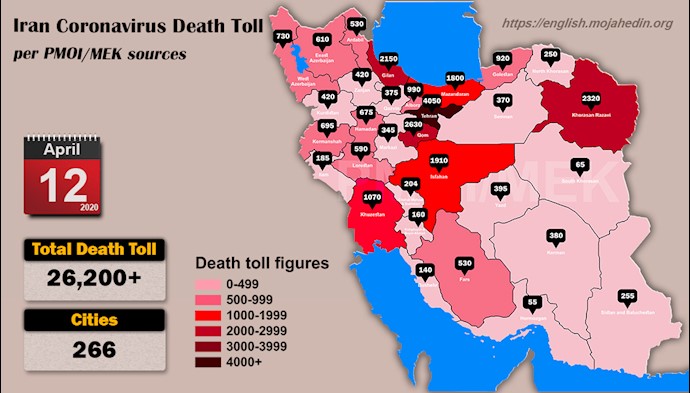Reporting by PMOI/MEK
Iran, April 12, 2020—More than 26,200 people have died of the novel coronavirus in 266 cities checkered across all of Iran’s 31 provinces, according to reports tallied by the Iranian opposition People's Mojahedin Organization of Iran (PMOI/MEK) as of Sunday afternoon local time, April 12. The official death count declared by the regime is 4,474, less than a fifth of the real figure.
The death in various provinces include: 4,050 in Tehran, 2,630 in Qom, 2,320 in Razaiv Khorasan, 1,070 in Khuzestan, 990 in Alborz, 920 in Golestan, 730 in West Azerbaijan, 675 in Hamedan, 530 in Ardabil, 530 in Fars, 420 in Kurdistan, 420 in Zanjan, 395 in Yazd, 140 in Bushehr, and 65 in South Khorasan. The latest reports indicate a major spike in the number of people killed in the city of Shiraz, south-central Iran, and the pace of people dying in Tehran Province has increased. This is in addition to cases registered in other provinces.

Over 26,200 dead of coronavirus (COVID-19) in Iran
Mojtaba Yazdani, deputy municipality chief in Tehran, said a new section in the famous Behesht-e Zahra Cemetery has been allocated for coronavirus victims and “10,000 new graves” have been prepared. A 40-foot long refrigerator, two other such facilities, two 12-meter long refrigerator containers and crisis silos, equipment and supplies have been prepared, according to a report wired by the state-run IRNA news on Sunday, April 12. Prior to this the Secretariat of the Iranian opposition National Council of Resistance of Iran (NCRI) issued a statement on March 21 indicating that a contract had been signed for 10,000 new graves in Beheshte Zahra Cemetery.
Iranian regime President Hassan Rouhani once again attempted to justify the criminal decision of returning people to work and ridiculously claimed that the regime is actually in a better situation in the fight against coronavirus when compared to o European countries.
Following the Iranian regime supreme leader Ali Khamenei’s deceptive remarks on April 9 supporting end of quarantine period, the #Coronavirus Task Force announced on April 10 that two-third of government employees will start to work on April 11.#Iranhttps://t.co/1c5DCtPVPC
— People's Mojahedin Organization of Iran (PMOI/MEK) (@Mojahedineng) April 11, 2020
These remarks are questioned even among the regime’s own officials. Alireza Zali, head of the Tehran Coronavirus Control Task Force questioned the recent decision to send people back to work. “We won’t see the impact today… Our COVID-19 cases will be seen in the next two weeks… Our medical staff members are exhausted and suffering from various issues. Some have died. Some can no longer work. Despite all that they will have to be prepared for a new jump in this illness. Furthermore, we have not reached the peak in Tehran,” he said on Saturday night in an interview with the regime’s state TV Channel 5.
One epidemiology and infectious disease expert in Iran wrote, “During the next few days the number of deaths will reach unbelievable new heights… Considering the information we have obtained I am telling you that the number of new COVID-19 cases across the country has not decreased. What is worth noting is that only six percent or a maximum of ten percent of our patients have been identified. Other cases have quarantined themselves in their homes and prefer to visit medical centers on lesser occasions. The country has yet to witness its peak in this illness.”
As the coronavirus epidemic spreads across all of Iran, senior regime officials are voicing grave concerns about the consequences of the mullahs’ criminal policies in response to the COVID-19 crisis. #Iran#coronavirus https://t.co/8G8jlSAaJP
— People's Mojahedin Organization of Iran (PMOI/MEK) (@Mojahedineng) April 10, 2020
In recent days, an increasing number of regime officials are suggesting that the regime pay the salaries of workers from its economic empire instead of forcing them to go back to work. These officials understand that the consequences of reopening the economy and flaring the spread of the virus can have dire consequences for the regime and can result in widespread social protests. Among the regime’s assets, officials are referring to the Execution of Imam Khomeini’s Order Office (EIKO), Astan-e Qods, and Mostazafan Foundation, all overseen by Khamenei himself and collectively worth over $200 billion. These institutes can easily cover the costs of the lives of the impoverished people and can obviate the need to lift nationwide quarantines. But Khamenei has yet to tap into his vast economic fortune and spend a dime on the needs of the people.
Deputy Health Minister Iraj Harirhci warned, “Coronavirus deaths are more numerous among the poor. They have less access to sanitary products and medical services. The economic impact of coronavirus on the impoverished people is greater than the rich. People who are under the threat of losing their job and daily workers are hit worse from this situation.
A doctor from a hospital in Shahr-e Ray, south of Tehran, said, “A lot of the people who have COVID-19 symptoms and are among the poor segments or live in slums, when we tell them they must take the coronavirus test, they don’t accept and they say, 'If I stay in the hospital for several weeks, who will pay for the expenses of my wife and kids. I will lose my job. Please treat us with medicine.'”
Meanwhile, the regime’s fear of possible uprisings continues to mount. Morteza Mobalegh, the former political and security deputy of the interior minister, told the state-run Arman newspaper, “Social and security problems are a threat not only to the post-coronavirus times, but they might occur in the present conditions. If the government doesn’t manage this smartly and with prudence, we might face severe social problems.”
Former health minister Mostafa Moein warned, “The possibility of the repetition of social and political tension that we’ve seen in the past 2-3 years exists… Our country will be grappling with the psychological, social, economic, and political consequences of the coronavirus pandemic in the short and long term.”
Iran coronavirus outbreak death toll interactive map




